
The Australian shepherd is a cattle dog that is often mistaken as coming from Australia.
©Alpeek/Shutterstock.com
Australian Shepherds are some of the cutest, most lovable, and goofiest dogs around. They are bouncy, filled with energy, and always have something they need to tell you. All of which makes them even more lovable. It will surprise you to know some background on this beloved breed unless you have already done your homework.
This article will delve into what makes an Australian Shepherd tick and what some of the best and rarest colors and patterns are for the breed.
First, a Little History
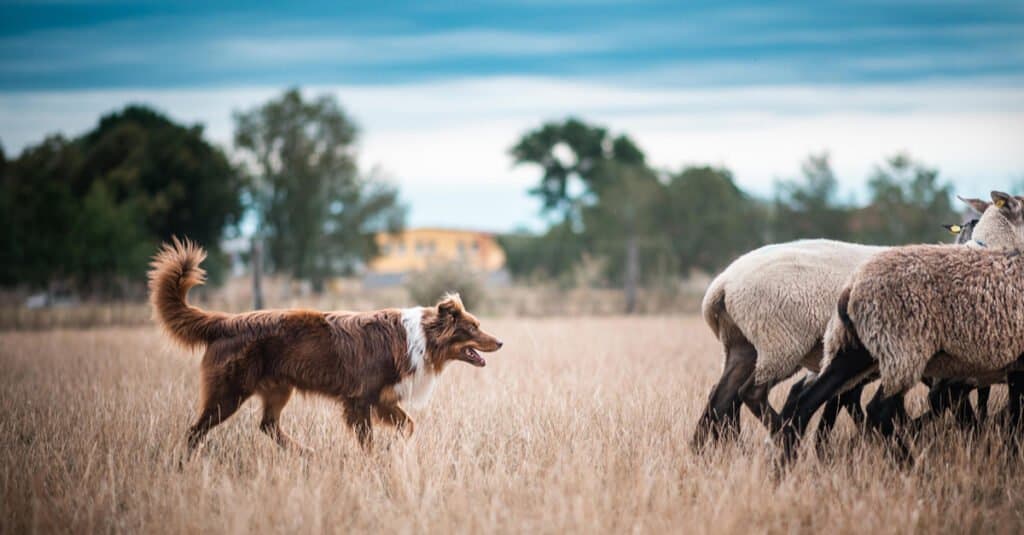
The Australian shepherd is one of the most popular dog breeds in the United States.
©Ellis Berankova/Shutterstock.com
Australian Shepherd didn’t originate in the great outback, and they didn’t make it that way for some time. Initially, the Australian Shepherd was a descendant of herding dogs from Spain. In the 1500s, these Spanish sheepdogs came to North America with the sheep they guarded. Some think it was the Carea Leonés breed that made up those dogs. Australian Shepherds have the light eye color and merle coat found in some Australian Shepherds. The sheepdogs of 1500s Spain may have also included the Basque Shepherd and the Pyrenean Sheepdog.
The breed itself developed in California in the 19th Century. Supposedly, the dogs are descendants of the originating sheepdogs from Spain, and the dogs were brought over with imports from Australia and New Zealand. The dogs from those countries were likely collies. After the perfect herding dog was created in California, the dog was given the name of part of its origin species and became known as the intelligent medium-sized dog we all love today; the Australian Shepherd.
General Physical Attributes

Australian Shepherds are great herding dogs whether it be sheep, cattle, or the mighty ball.
©iStock.com/Brad Covington
Appearance: The Australian Shepherd is a dog with a double coat which helps keep them cool in heat and warm in colder temperatures. The dog breed has wavy longer hair with a thick undercoat with a coarse, wavy top coat. Some dogs are born without a tail, and some have a long tail. Though it is a cruel practice, some countries, like the United States, require it for dog shows by the American Kennel Club.
Size: These dogs stand between 18 – 23 inches at the shoulder and can weigh between 35 and 70 pounds.
Energy Level: They are athletic and high-energy. The Australian shepherd needs plenty of daily exercise, or they may become destructive by chewing and other forms of boredom. They absolutely love playing ball and will obsess over when you will play next, so get your throwing arm ready.
Temperament: They are athletic, herding dogs that display an instinct to herd in many aspects of life outside the farm. They may try to herd other pets or children. These are very loyal, friendly dogs with high intelligence and adaptability.
Health: The Australian shepherd is reasonably healthy but can have some issues as they age. Epilepsy and vision issues can occur from the double merle gene. It causes these dogs to be born deaf or blind. The dogs with blindness typically have white fur and, over half the time, light blue colored eyes. Hip dysplasia is common in the breed, but not every case is painful. If they do have it, it tends to worsen with age.
Lifespan: They generally live between 11 and 14 years, with some cases being shorter or longer.
Issues: Because the Australian shepherd is a herding dog but also a family dog, things can become complicated with small children around. While it can certainly be amusing to watch your dog herd small children into a group, it can also be why these dogs end up surrendered to the animal shelter. Check out some videos on how these dogs go about herding sheep or cattle. They tend to nip at the animals that they are herding. This isn’t a full-fledged bite, but watching your 22-month-old baby stagger around on their new walking legs while your dog nips at the baby’s legs can lead to an untimely death for your dog. Make sure to do plenty of homework before adding a herding dog to your family.
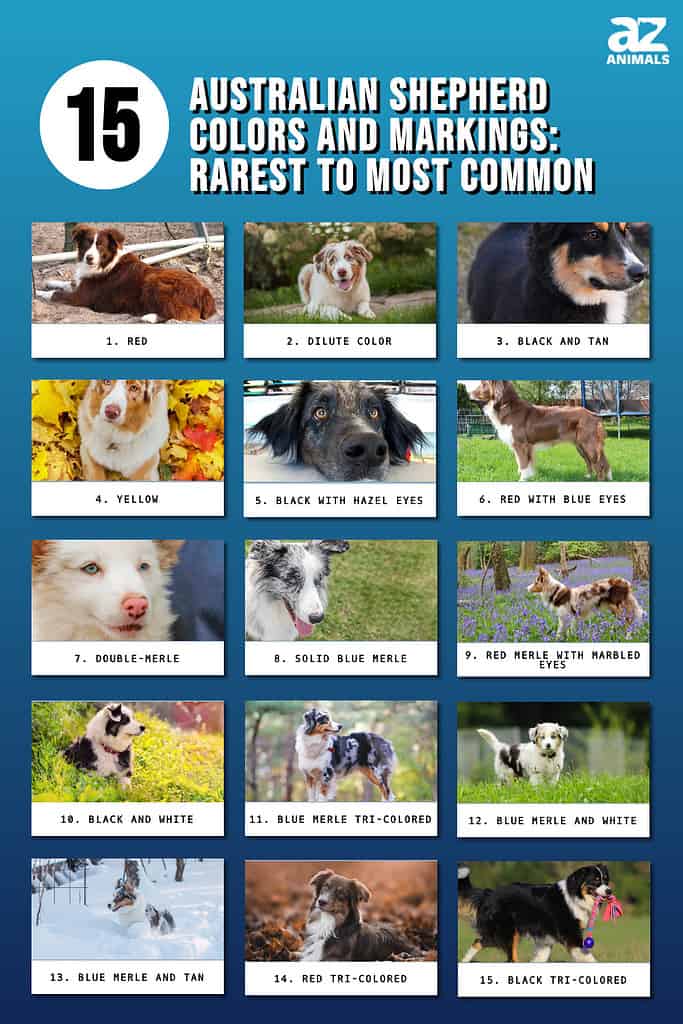
15 Rarest to Most Common Colors and Markings
The four primary colors that Australian shepherds typically come in are; red, red merle, black, and blue merle. There are plenty of uncommon colorings, including a yellow Australian shepherd, which is the color of a yellow labrador or can be as dark golden yellow as a golden retriever. No matter what color Australian shepherd you have, you will undoubtedly fall head over paw in love with this easy-to-obsess-over breed.
1. Red
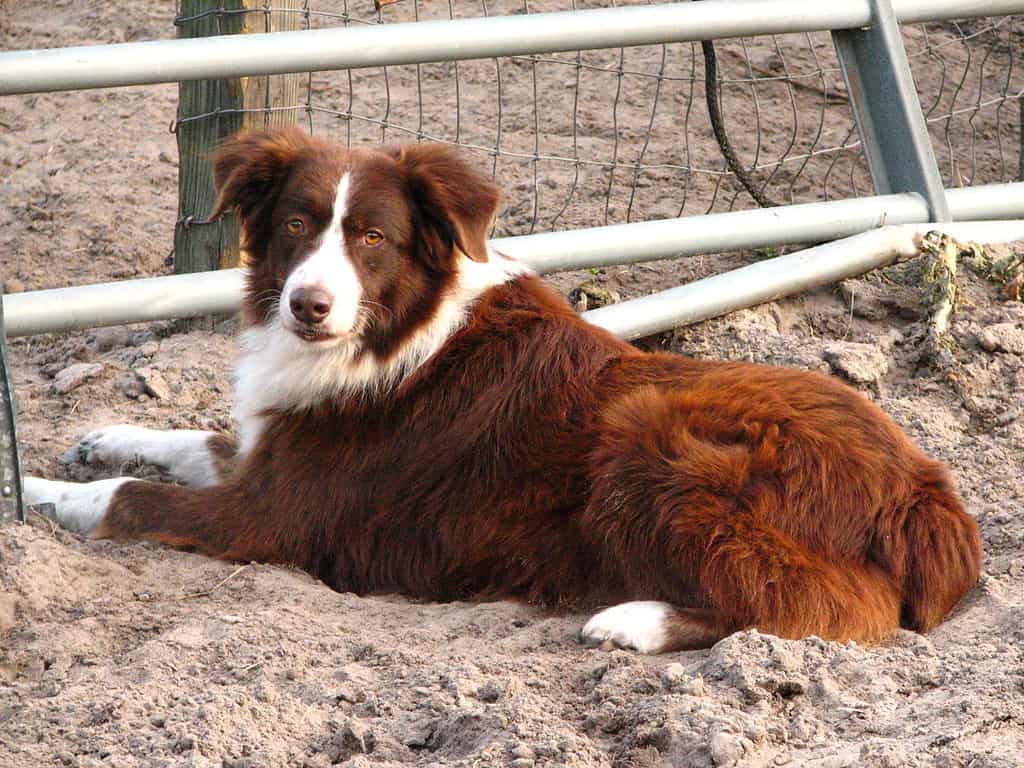
A red Australian shepherd is very rare. This photo is of a red bi-colored Australian shepherd.
©monica king / CC BY 2.0 – License
A red Australian shepherd is very rare. This photo is of a red bi-colored Australian shepherd.
This variation of a red Australian shepherd is without any white, black, tan, or copper coloring. The red coloring can be any shade of red. It can range from a light cinnamon to a dark liver-colored hue. Breeders do not strive for this coloring in their dogs because it is thought not to be as attractive as the bi or tri-colored dogs. So it’s not that it is an impossibly difficult color to achieve; it is more that the breeder avoids it. The mutation is created by pairing dogs with the ee recessive form of the E gene. Some believe their beautiful red coats are unique and give them an exotic look.
2. Dilute Color

The dilute-colored Aussie can be any shade but a watered-down version of the actual color is usually seen.
©Maria Ulzutueva/Shutterstock.com
The dilute-colored Aussie can be any shade, but a watered-down version of the actual color is usually seen.
A dilute-colored Australian shepherd can be any of the primary colors, just a much lighter and softer version. This coloration is becoming more common, and much that is seen are the black and dark red colors becoming softer. It does not lighten tan or copper colors, but it likely happens with some dogs. The dilute color is a recessive gene mutation that causes the colors to lighten. Sometimes dilute Australian shepherds have reddish-colored noses and light or light-flecked eyes. The recessive gene mutation does not cause these dogs any health problems.
3. Black and Tan
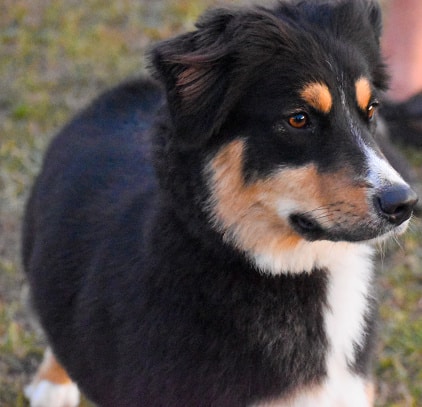
This is not a bi-colored black and tan Australian shepherd, but they are incredibly rare. Do your best to visualize this dog without any white on it.
©Rachelle007/ via Getty Images
The elusive black and tan Australian shepherd is extremely rare but looks like rottweiler coloring on an Australian shepherd. The dog has a shade of tan on their face, neck, chest, and sometimes feet and tail. These dogs also have deep golden brown eyes.
4. Yellow
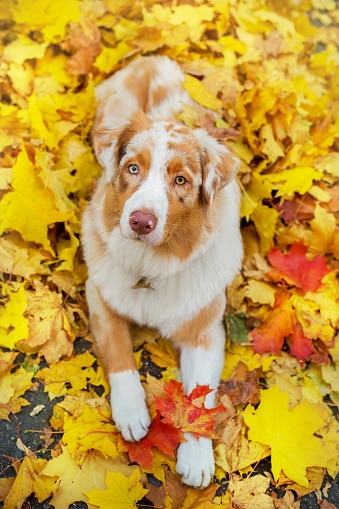
A yellow-colored Australian shepherd is very rare but is a beautiful golden retriever shade of orangish yellow.
©Nemyrivskyi Viacheslav/ via Getty Images
The Australian shepherd can inherit a yellow recessive gene that makes copper and tan appear to take on more of a yellow note. Yellow Aussies can be as light as a pale yellow or as dark as a golden yellow. For a dog to be yellow, both parents must have the yellow recessive gene, the E-locus gene. These dogs can have other colors on them, but they may take on a yellowish tint.
5. Black with Hazel Eyes
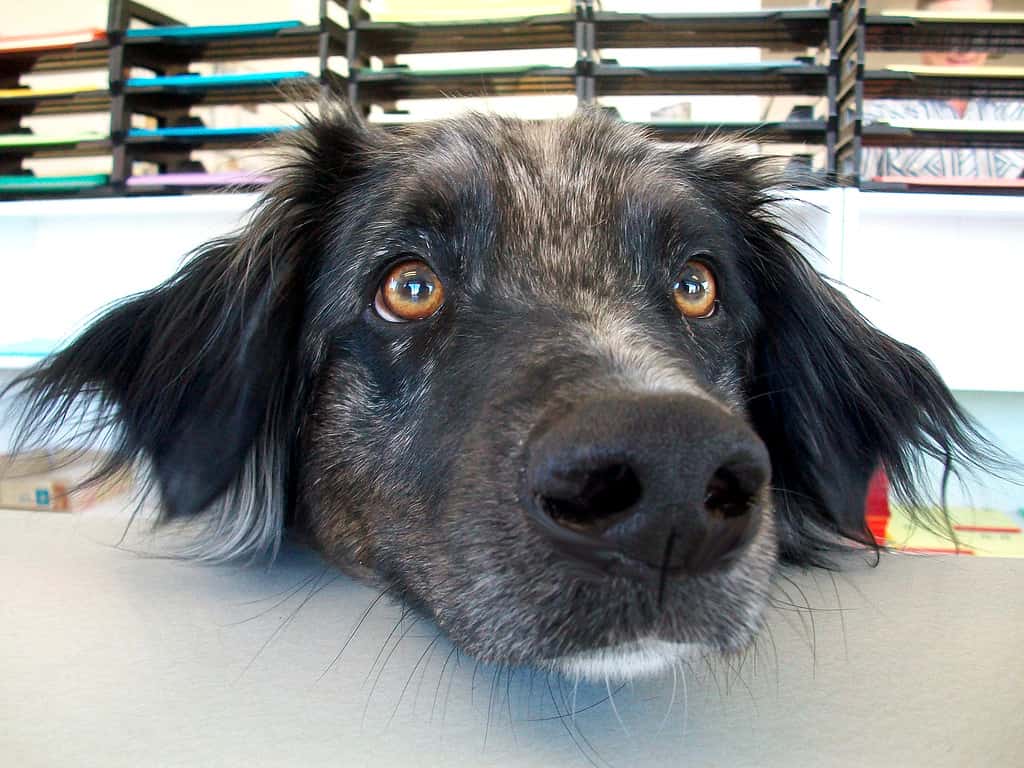
A black merle Australian Shepherd with brown eyes. A photo of a black Australian shepherd with hazel eyes is almost as hard to find as the actual dog!
©ItsWolfeh / CC BY-SA 3.0 – License
Almost all black Australian shepherds have deep brown eyes, but some can have different variations of them. The rarest eye color among black dogs is hazel, a combination of green and brown. It is also very rare to find a completely black Australian shepherd. Most are still considered true black by the AKC but may have a white mark on their chest. To find a hazel-eyed, completely black Australian shepherd would be very difficult.
6. Red with Blue Eyes

A red bi-colored Australian shepherd since finding a photo of a red Australian shepherd with blue eyes.
©Trickdog-Fina / CC BY-SA 3.0 – License
Red Australian shepherds can have a solid, bi, or tri-color to their coats. It is uncommon to find an Aussie with only red and white in their coat. Most have a bit of tan or copper mixed in, but if it is a small enough amount, they are still classified as red bi-colored to the AKC. The true red and white dogs will have red coats with white markings on their face, chest, feet, and tail.
7. Double-Merle
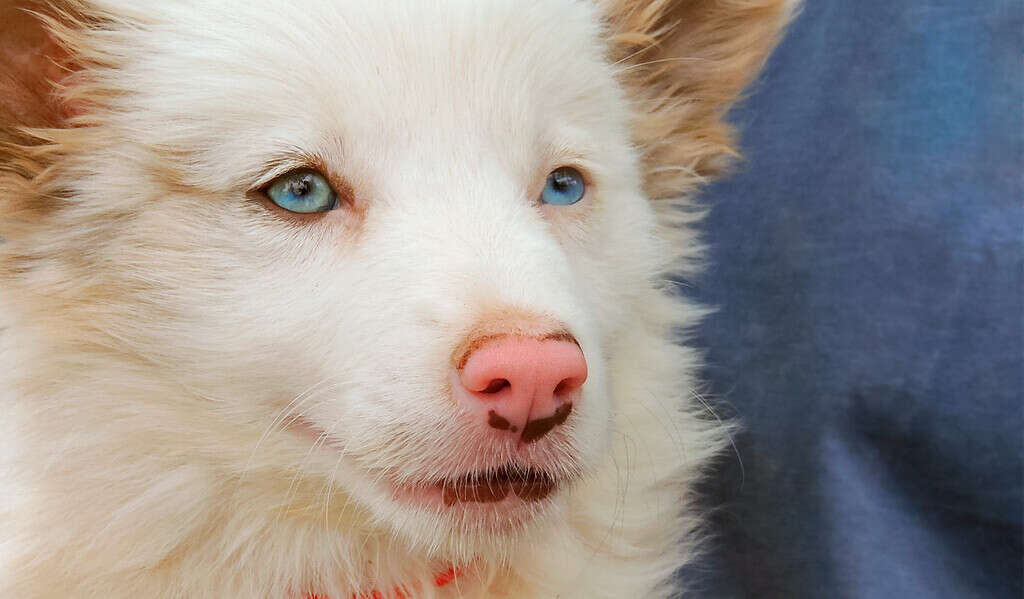
Not every double-merle dog is deaf and blind, but most are at least partially.
©Monique Oliveira/ iStock / Getty Images Plus via Getty Images
The double-merle Australian shepherd can come with some unfortunate defects. One of those is deafness. Another creates a lengthy list of eye defects, including blindness. Not every double-merle dog is deaf and blind, but most are at least partially. The dogs frequently have hearing issues due to the lack of pigmentation in the inner ear. True double-merle dogs do not have pigmentation in their skin, noses, or eyelids. Some Australian shepherds can be white and might look like a double-merle. However, if you look closely at the color of the inner eyelids, pigmentation under the fur on the skin, and on the nose, you will notice darker pigmentation. These white dogs can have black noses and dark eyes.
8. Solid Blue Merle

A solid blue merle Australian shepherd is not nearly as common as the bi and tri-colored blue merles.
©Wirestock/ via Getty Images
Solid blue merle Australian shepherds are not easy to find, even with the best breeders. To make it work, the blue merle dogs must have only one copy of the merle gene. Otherwise, they end up with vision and hearing defects. These beautiful speckled dogs are what many people look for in an authentic Australian shepherd. These genuine blue merles, along with some of the other colorings, have black speckles all over their bodies and can even be seen on their long noses, paws, and insides of their ears.
9. Red Merle with Marbled Eyes
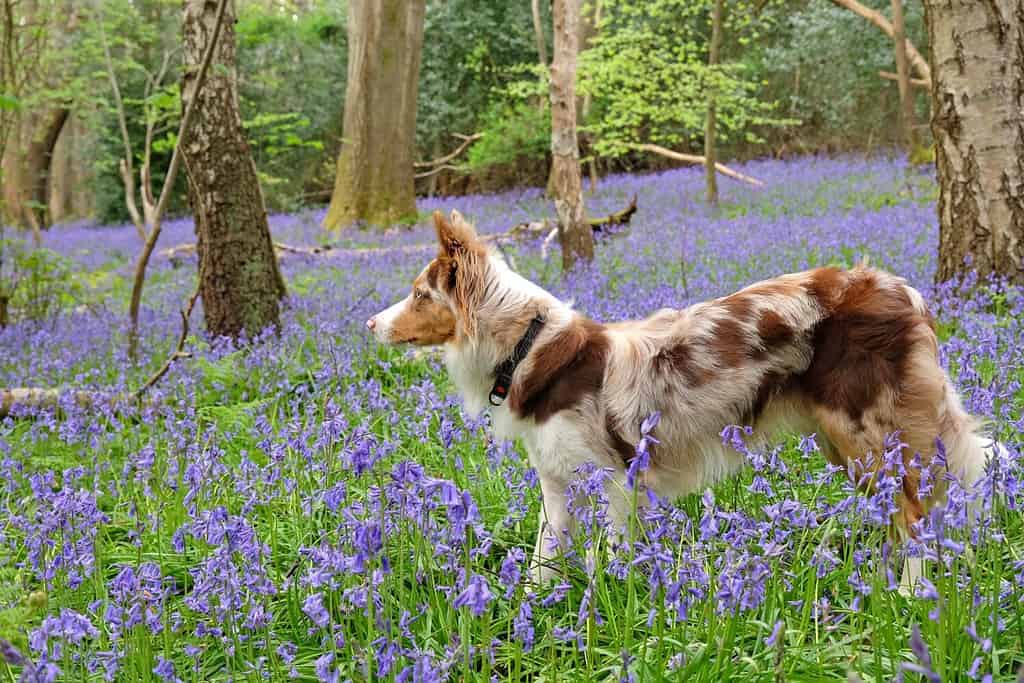
Red Merle Aussies with marbled eye color are some of the prettiest Australian shepherds.
©Alex Manders/Shutterstock.com
The sweet-tempered red merle Australian shepherds come in tri, bi and single colors. Red shepherds typically have a brownish-amber eye color, but the red merle can have blue, brown, and amber pigmentation variations. These dogs tend to have beige or silvery-colored fur with red spots. It is uncommon to see a red merle dog with two different colored eyes. Most have a marbled look to them, with either flecks of blue with brown eyes or flecks of brown with blue eyes.
10. Black and White

A black and white Australian shepherd is not as common as the tri-colored black dogs though some people just like the bi-colored dogs more.
©Electrokardiogram / CC BY 4.0 – License
The black and white dogs aren’t rare like the all-red Australian shepherd, but they are not commonly seen. When someone does see one, they are often mistaken for border collies. Since the Australian shepherd dog was created by combining collies from New Zealand and Australia with sheepdogs from Spain, it is no wonder these black and white Aussies look like Border collies! Sometimes these formal attire-wearing dogs can even have bright blue eyes, though it is rare. Native Americans have said these blue-eyed black and white Aussies look like they have ghost eyes and have regarded them with respect.
11. Blue Merle Tri-Colored
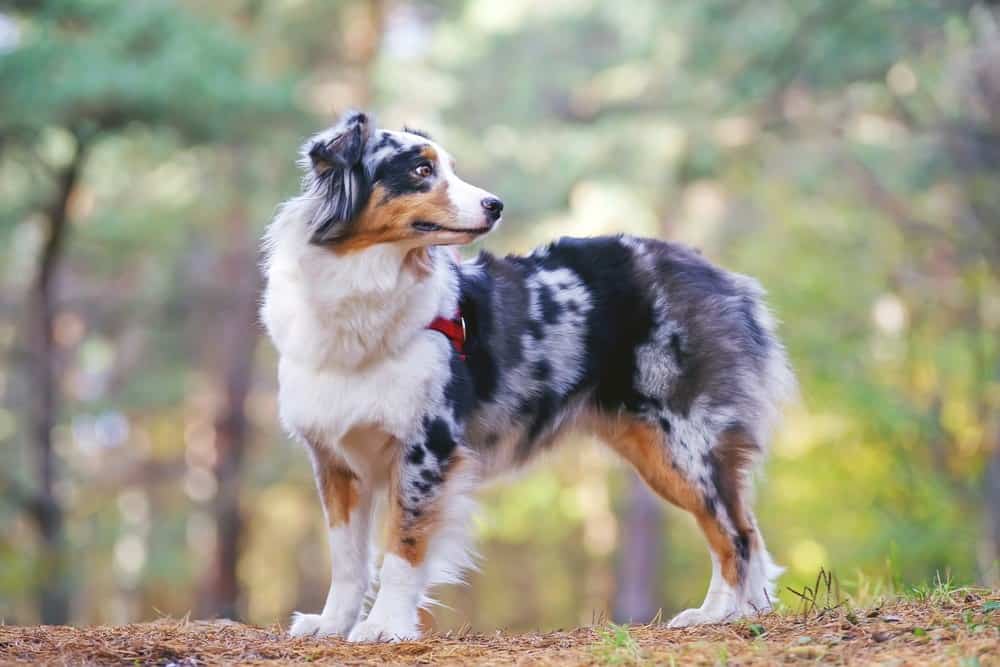
The tri-colored Australian shepherds are one of the most sought-after color variations.
Almost like the changing colors in autumn, these Australian shepherds’ coats have beautiful contrasting colors that stand out. These dogs typically have a blue merle body with a black spot on the back with white, tan, and copper highlights around the face and feet.
Blue Merle Aussies have a higher price tag and a higher risk for vision issues due to their genetic makeup. Coloboma is an eye condition that occurs when the cornea of the eye doesn’t fully develop in the womb. Dogs with this condition can have eyes with pupils that do not contract or dilate properly. The condition makes it difficult to see in bright light, which may not be ideal if you are looking for a herding dog. This is not solely exclusive to merle-colored dogs but can happen with any of the colors. It’s best to check with the breeder up front to avoid dogs with this condition.
©Eudyptula/Shutterstock.com
12. Blue Merle and White

Blue merle and white Aussies are the second most popular blue merle color type. The above puppy is not a white and blue merle variation because it has tan on its face.
©zzsulc/Shutterstock.com
These adorable dogs also come in blue, merle, and white. It can be rather confusing since there is also a white Australian shepherd with blue merle markings. Also, the only difference between the tri and bi-colored merle is that the bi-colored one only has white and blue merle without any tan or copper color patterns on the feet, face, or chest. These dogs have a white chest, white tail and face markings, and white feet while their body remains mottled blue merle.
13. Blue Merle and Tan

It can be challenging to determine if the Australian shepherd in question is tri-colored or blue merle and tan since the two can look similar.
©VSFP/iStock / Getty Images Plus via Getty Images
This variation of the blue merle Aussie combines grey fur with black patches and only tan highlights. The tan can appear on the face, tail, chest, or feet though the chest is usually white. It can be challenging to determine if the Australian shepherd in question is tri-colored or blue merle and tan since the two can look similar. Some blue merle variations can have one brown eye and one blue eye, whereas others may have two marble-looking eyes with both colors.
14. Red Tri-Colored

The tri-colored red Aussie is a beautiful and soulful-looking dog.
©Jithu B Mohan/Shutterstock.com
The adorable look of the red tri-colored Australian shepherd is also one of the most common. These dogs generally have warm golden brown eyes, a white chest, and possibly part of the face and feet. They most often have a face that is one shade of red, along with cute, differently colored eyebrows.
15. Black Tri-Colored

The black tri-colored Australian shepherd is the most common.
©Melounix/Shutterstock.com
Australian shepherds are most often black tri-colored. This coloring is very reminiscent of a Burmese Mountain dog. However, the Australian shepherd is much smaller and leaner than the mountain dog. The black coat generally goes along with a white face, belly, and chest. Sometimes the feet are also white. Red or copper-colored markings are also located near the white. No two Australian shepherds look alike, making them even more unique.
Your New Best Friend
You simply can’t go wrong when choosing an Aussie to love for their entire lives. They are very friendly, happy medium-sized pups with an excellent demeanor. They are not aggressive in a typical way but can be nippy when trying to herd animals, children, or you! These are great dogs for children as long as you understand the ingrained herding instinct. If you have a young child and want to add an Australian shepherd to your family, get a puppy from a reputable breeder or Australian shepherd rescue. A puppy growing up with a child is much less likely to nip or become impatient with a child than an older, established Australian shepherd.
Regardless, these are wonderful dogs whether you choose to add one to your farm or your home. When it comes down to finding an excellent friend for the next 11-14 years, choosing an Australian shepherd will be one of the best choices you make.
Summary of Australian Shepherd Colors and Markings: Rarest to Most Common
| Rank | Australian Shepherd Colors |
|---|---|
| 1 | Red |
| 2 | Dilute Color |
| 3 | Black and Tan |
| 4 | Yellow |
| 5 | Black with Hazel Eyes |
| 6 | Red with Blue Eyes |
| 7 | Double-Merle |
| 8 | Solid Blue Merle |
| 9 | Red Merle with Marbled Eyes |
| 10 | Black and White |
| 11 | Blue Merle Tri-Colored |
| 12 | Blue Merle and White |
| 13 | Blue Merle and Tan |
| 14 | Red Tri-Colored |
| 15 | Black Tri-Colored |
The photo featured at the top of this post is © ItsWolfeh / CC BY-SA 3.0 – License / Original
Ready to discover the top 10 cutest dog breeds in the entire world?
How about the fastest dogs, the largest dogs and those that are -- quite frankly -- just the kindest dogs on the planet? Each day, AZ Animals sends out lists just like this to our thousands of email subscribers. And the best part? It's FREE. Join today by entering your email below.
Thank you for reading! Have some feedback for us? Contact the AZ Animals editorial team.







